| Feb-25-10 | | elohah: Actually, when you think about it, what's $25 dollars anyway? With dues raised $4 dollars, I'm already excommunicated. |
|
| Mar-21-10 | | wordfunph: who could stop two unopposed pawns by Napier? if i were Jnaowski, i offered Napier my hand on move 38.. |
|
| Jan-28-19 | | zydeco: Probably one of the best wins of Napier's career. He has complete dark-square domination with 24.Qc5. |
|
Mar-05-23
 | | KEG: I agree with <zydeco> that this was a fine game by Napier. Janowski was obviously overconfident and played like a lunatic for much of the game. To Napier's credit, he was not intimidated and patiently exploited Janowski's wild play and scored the full point. Not a perfect game by any means, but a good workmanlike performance by Napier. Napier could be a tough out for the top players. In addition to defeating Janowski in this game, he drew twice against Tarrasch, drew and then won against Wolf, won against Tchigorin, and defeated Mieses. But losses against von Popiel, Mason, and Albin, left him with an even score. This pattern was even more pronounced later that year at Hanover 1902, where Napier had a fine score against the prize winners (three wins, one loss [to Janowski] and three draws) but only finished in a tie for 5th and 6th as a result of a mediocre score against the non-prize winners (four wins, three losses, and three draws). At Cambridge Springs 1904, however, Napier got wiped out by the top players (no wins, four losses, and four draws). He was a talented player who never quite fulfilled his potential. Janowski, by contrast, took a hit with this loss. He had begun Monte Carlo 1902 on a tear, scoring 5.25 points in the first six rounds (drawing both his games against Maroczy), but then went into a tail-spin for a few rounds. But after this loss, Janowski returned to top gear and all but one of his remaining games (losing, as he always seemed to at this stage of his career, to Mason). Had Janowski won this game, and if all other things remained as they were, he would have taken first place as he did at Monte Carlo 1901, and this time against a much stronger field, instead of ending up in third place. Had he even drawn both games against Napier (this game and the replay) he would have tied for second with Pillsbury). One unpleasant side of Janowski was on display in this game. As <wordfunph> has rightly said, he should have resigned by move 38. He was down two (passed!) pawns in a minor piece ending. Dragging on the game for another more than 20 moves was something akin to an insult to Napier. I should not that the commentary for this game in the Tournament Book came from Deutsche Schach-zeitung ("DSz"). As will be seen, this commentary was often quite poor. 1. e4 e5
2. Nf3 Nc6
3. Bb5 a6
4. Ba4 Nf6
5. 0-0 Be7
6. Nc3
A line that is no longer popular but which is about as good as the more usual 6. Re1, if a tad less enterprising. 6... b5
7. Bb3 d6
8. h3
Safe but unduly passive. 8. a4 or 8. Nd5 are more promising if White is playing to win. Napier, however, might have felt a draw with Janowski was a good result. Of course, once Janowski started playing like a maniac, Napier's aspirations got higher in this game. 8... Na5
9. d3 0-0
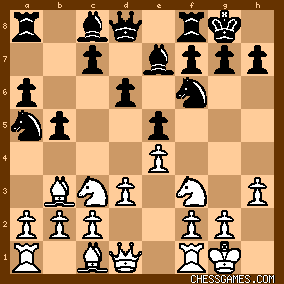
click for larger view10. Bg5
I was all set to denounce this as a "nothing move" and an indication that Napier was straining to exchange pieces en route to a draw when I noticed that Emmanuel Lasker played the very same move against Rubinstein at Berlin 1918. So, and since the move is not all that terrible, I have relented and given Napier a pass. 10... h6
11. BxN
Having said "A," Napier pretty much had to say "B." 11... BxB
12. Nd5 c6
12...Bb7 as recommended by DSz, is also good.
13. NxB+ QxN
14. d4
"!"--(DSz).

click for larger viewJanowski had achieved an approximately even position at this point as Black. But the exchanges suggested a draw might be the outcome, and--as will from here be seen--that result was unsatisfactory to Janowski in this his first game against the young American. Indeed, Janowski was to defeat Napier in their other two games (at Hanover 1902 and at Cambridge Springs 1904). But in this encounter, he went overboard in trying to force play from here and soon wound up in a difficult...and later a lost..position as a result. |
|
Mar-05-23
 | | KEG: Post II
14... g5?!
"?"--(DSz)
"Weak. Best was 14...Rfd8 as 14...exd4 15. Qxd4 QxQ 16. NxQ c5 17. Bd5 was also weak." --(DSz) 14..Rd8 is indeed OK for Black, as is 14...Bb7 or 14...Qg6. But 14...exd4 is not "weak." The error in the line given by DSz is 16...c5 which does indeed give White the edge. Correct is 16...Re8 after which Black is fine. Janowski's move is typical of his often wildly aggressive play. But the text itself--though an unsound effort to stir up action on the King's side-- was not the reason he lost here, though it did give him a difficult position. 15. dxe5 exd5
16. Nh2

click for larger viewMaking his own King-side preparations and eliminating 16...b4 as a threat. Napier might have preceded this move with 16. Qd3, aiming at 17. Nh2 and 18. Qc3. 16... Qg6
Still looking for trouble. Sounder and better were 16...Rd8 or 16...Nb7. Janowski--lover of Bishops--could also just have played 16...NxB, which is what I was expecting from him as I played over the game. 17. Qe2
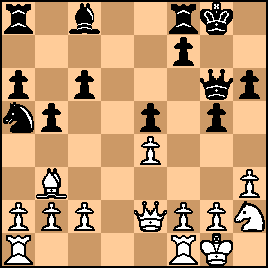
click for larger view17... Nb7
"?"--(DSz)
DSz preferred 17...NxB. Given the trouble Janowski was to face by allowing White's Bishop to survive, the move recommended by DSz was probably Janowski's best practical chance. Also reasonable for Janowski here were 17...Rd8; 17...Be6; or--if he wanted to follow up on his attacking concept--17...h5?! But Janowski's actual move, objectively, was probably now all that bad. 18. Qe3 Nd6
Consistent with his prior move, though 18...Re8 or 18...Kg7 look sounder. But the text, once again, was very much in Janowski's enterprising style. 19. f3
Napier refused to be distracted and continued to make simple, strong moves. The position was now: 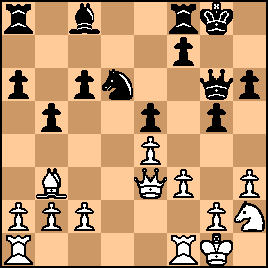
click for larger view19... Ne8?
Despite his messing around to this point, Janowski was far from lost--until this clunker, which--though not mentioned by DSz--was probably the losing move. It was to Napier's credit that, from this point on, he gave Janowski no chance to recover. 20. Rad1
A simple, strong move. He could just as well have moved his other Rook to d1. 20... h5
"?"--(DSz)
Given his position, Janowski's move was arguably his best chance to try to mix things up. He might also have tried 20...a5. 21. Rd8
Of course:
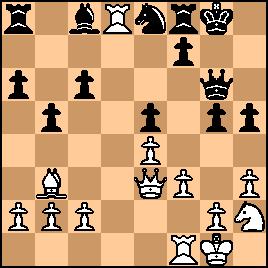
click for larger viewOne can only imagine Janowski's chagrin as he pondered the board. Meanwhile, Napier was doing his best Karpov imitation, slowly strangling his famous opponent. 21... Qf6
22. Rfd1
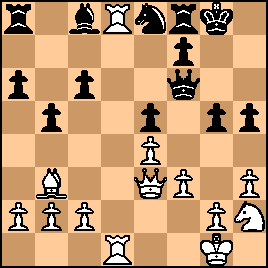
click for larger viewHere, Janowski decided desperate measures were required. As will be seen, he almost managed to intimidate Napier sufficiently to get back into the game--but not quite. |
|
Mar-05-23
 | | KEG: Post III
22... Bb7?
It is easy to see why Janowski did not fancy allowing Napier to maintain a Room on d8. But if that was his goal, 22...Ng7 was much better. After the text, Black's Queenside becomes as full of holes as a piece of Swiss cheese, and Napier soon wins material. He might also end up losing a pawn after 22...Ng7 as well, but he would be poised to offer stiffer resistance in any coming endgame. Arguably best for Janowski here was 22...a5, but even then he would be on the verge of defeat. 23. RxR BxR

click for larger viewTalk about weak pawns!
24. Qc5
<zydeco> rightly says that this gave Napier "dark-square cominance." But perhaps even stronger was 24. Rd7 (e.g., 24...Ng7 25. Qb6 Ne6 26. Qxa6). <DSz> correctly notes that 24. Qb6 would win a pawn for White. But after 24...Nd6 25. Qxa6 Bb7 Black would be better situated than after Napier's move. 24... a5

click for larger view25. a4
"!"--(DSz)
The text, which addresses the threat to the White Bishop posed by Janowski's last move, is indeed strong and almost certainly sufficient to win, but 25. Qa7 looks crushing (if then 25...a4 26. Bxa4 and then 27. QxB. 25... bxa4
26. Bxa4 Ng7
27. Bb3
Once again, this was good enough to win, but surely 27. Qxa5 was simpler. Now he had to contend with 27...a4. 27... a4
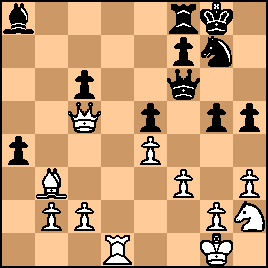
click for larger view28. Bxa4
There was no need to rush to pick up a pawn. White was sure to gather material before long. But the text allowed Janowski to play Ne6. So 28. Bc4 was much stronger. 28... Ne6
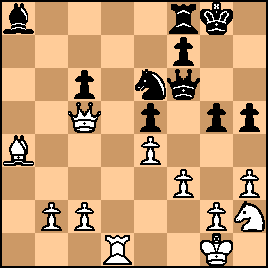
click for larger view29. Qe3
Perhaps time-pressure, with the move-30 time control, was starting to raise its ugly head. The text likely did not blow the win, but 29. Qa7 (or even 29. Qb6) was far more decisive. 29... Rd8
30. c3
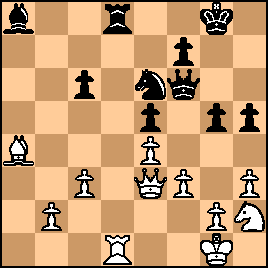
click for larger view30... c5?
Creating yet another weakness, perhaps because of time pressure (this was Black's last move before the time control) and now Napier romped to victory. Janowski had to play 30...Bb7, or perhaps 30...RxR+ followed by 31...Bb7. 31. RxR+ QxR
32. Nf1 Qe7
33. Ng3
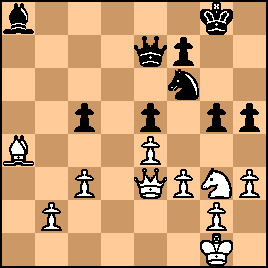
click for larger viewNo doubt recognizing the deplorable state of his position, Janowski tried some wild coffee-house tactics beginning here. Predictably, this only made things worse, and the game was then prolonged because Janowski stubbornly refused to resign. |
|
Mar-05-23
 | | KEG: Post IV
33... Nf4?!
A wild attempt to stir up complications that was not immediately punished by Napier as it might have been. The most stubborn resistance would have been offered by 33...Ng7. 34. Qd2
Good enough to keep his winning edge, but the faster killing move was the nasty 34. Nf5! After the text, the position was:

click for larger view34... c4?!
Still swinging for the fences. 34...g4 would have been more consistent with his 33rd move. 35. Nf5
Better late than never.
35... Qf8?
Hopeless. but Janowski by this point was a dead duck anyway, so my "?" is perhaps churlish, since even the "better" 35...Qc7 or 35...Qf6 would have provided scant chances of saving the game. As is obvious, Janowski did not relish tough defensive stands (though he played on this game for at least 20 moves longer than he should have. After Janowski's actual move, his position was beyond pathetic: 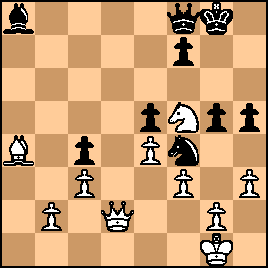
click for larger view36. Qd6
"!"--(DSz)
"The decisive move. Through the forced Queen exchange, White wins a second pawn)." (DSz) All true, but even more devastating were 36. Qd7, or 36. Bb5 or 36. b4. But Napier's move had the virtue of simplicity, since with the Queens off the board Janowski's tactical prowess would be of little avail. 36... QxQ
Everything else would have been even more hopeless. 37. NxQ Kf8
38. Nxc4
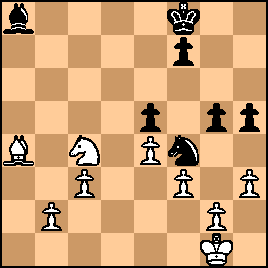
click for larger viewAs <wordfunph> has aptly said, this was--in the words of Mr.Shaibel in the Queen's Gambit--"where you resign." The winning plan here for Napier is not all that hard to divine: push the passed Queen-side pawns down the board. There is nothing Black could do about this (I would expect to beat Magnus Carlsen from here as White), and the balance of the game--which could not have been much fun for Janowski--was a manifest waste of time. One can quibble here and there with the methods employed by Napier, but they were direct and effective and allowed Janowski not the slightest chance to save himself. 38... f6
39. Nb6 Bb7
40. Bb5

click for larger view40. Bc2 might have been simpler, but Napier's idea was effective and ironic: get the Bishop to f1 to avoid any counter-play and push the b and c pawns. How frustrating it must have been for Janowski that the White Bishop that he decided not to trade off back on move 17 would now remove any chances he might have to offer any meaningful resistance. All Napier had to do was let it sit on f1, robbing Black of the d3 and e2 squares while defending the White pawn on g2 (thus allowing the White King to run amok) and protecting the advance of the White Queen-side pawns. Of course with Napier up two connected passed pawns, the game was dead lost for Janowski no matter how you look at it. |
|
Mar-06-23
 | | KEG: Post V
The balance of the game was of little interest.
40... Ke7
41. b4
The Queen-side pawns began to roll.
41... Kd6
42. Kf2
Napier played the ending with unruffled calm. 42. c4 was of course faster, but Napier was in no hurry, and was probably mindful of the move-45 time control. Losing on time was about the only way he could blow this easy win. 42... h4
Locking up the King-side couldn't be good for Janowski, but nothing else was of any use. 43. Bf1
43. Nc4+ was indicated. But Napier had now found a safe home for his Bishop on a square from which it could crush any efforts of resistance from Janowski: 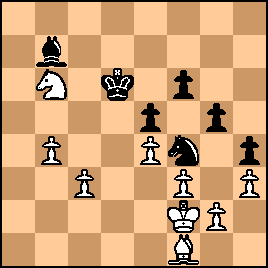
click for larger view43... Kc6
44. Na4
Now Napier's Queen-side pawns, with protection from both his minor pieces, could advance at will. 44... Bc8
45. c4
Here they come!
45... Be6
46. b5+ Kc7
47. c5 Bb3
48. Nc3 Ne6
49. c6
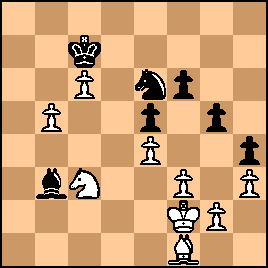
click for larger viewHad enough yet Janowski? Nope. He played on.
49... Nf4
50. Ke3
With the f1 Bishop protecting g2, Napier's King could join the show. 50... Kb6
51. Kd2 Be6
52. Na4+ Kc7
If 52...Ka5, White makes a Queen beginning with 53. b6! 53. Kc3 Bf7
Tantamount to resignation. The rest was child's play, the position now being: 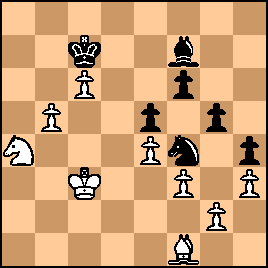
click for larger view54. Kb4
54. Bc4 was more elegant, but Napier saw no need to try anything subtle. 54... Be8
55. b6+!
Cute! :
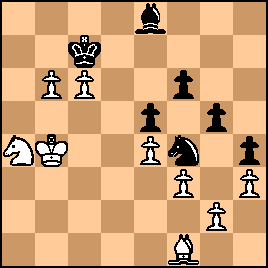
click for larger view55... Kd6
55...Kc6 loses the Bishop to ye old skewer (56. Bb5+) 56. c7
Janowski should surely have called it a day here, unless Napier was in danger exceeding his time with the move-60 time control approaching/ 56... Bd7
57. Nc5 Bc8
58. Ba6!
A pretty finale:
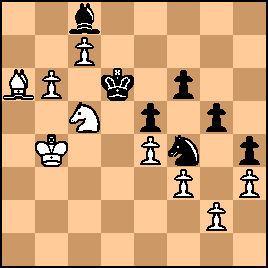
click for larger view58... Kc6
59. Ka5
By-passing the win of a piece with 59. BxB for this more pleasing closing. 1-0 |
|
|
|
|





